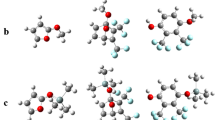Abstract
The formation mechanism of hydrogenated furans by coupling between terminal alkenes and aldehydes in trifluoroacetic acid medium were investigated by ab initio calculations, the main attention was focused on the study of the rate controlling step. Two possible mechanisms for this reaction involving unsaturated alkoxycarbenium ions or dioxolenium ions as a key intermediate were considered. It was shown that the mechanism of formation of 3-alkylsubstituted hydrogenated furans in trifluoroacetic acid under Prins reaction conditions preferably includes recyclization of 3-(2-hydroxyethyl)-1-trifluoromethyl-2,5-dioxolenium ions.






Similar content being viewed by others
References
Talipov RF, Sagitdinova KF, Vakulin IV, Safarov MG (2000) Syntheses based on 3-chloroacetoxytetrahydrofuran. Russ J Org Chem 36:1198–1200
Talipov RF, Safarov IM, Talipova GR, Safarov MG (1997) Kinetics of heptene-I interaction with formaldehyde in trifluoroacetic acid. React Kinet Catal Lett 61:63–68
Talipov RF, Safarov MG (1997) Prins reaction AdE as a set of transformations united by a common name. Bashkir J Chem 4:10–13
Talipov RF, Muslukhov RR, Safarov IM, Yamantaev FA, Safarov MG (1996) Synthesis of β-substituted tetrahydrofurans by Prins reaction. J Cheminform. doi:10.1002/chin.199604138
Shepelevich IS, Talipov RF (2002) RHF-MNDO calculation of the enthalpy of formation for substituted 1-hydroxy-2-oxa-5-pentyl carbocations. J Struct Chem 43:858–861
Talipov RF, Starikov AS, Gorina IA, Akmanova NA, Safarov MG (1993) Synthesis of dihydrofurans by Prince reactions in the trifluoroacetic-acid medium. Russ J Org Chem 29:1024–1027
Talipov RF, Starikov AS, Gorin AV, Safarov MG (1993) 1-Step synthesis of 2,3,5-trialkyl-2,5-dihydrofurans using the Prince reaction. Russ J Org Chem 29:748–750
Talipov RF, Mustafin MM, Safarov MG (1993) Prince reaction with participation of 4-vinyl-1-cyclohexen. Russ J Org Chem 29:127–129
Greenwood JR, Capper HR, Allan DR, Johnston GAR (1997) Tautomerism of hydroxy-pyridazines: the N-oxides. THEOCHEM 419:97–111
Yang X, Mague JT, Li C (2001) Diastereoselective synthesis of polysubstituted tetrahydropyrans and thiacyclohexanes via indium trichloride mediated cyclizations. J Org Chem 66:739–747
Loh T, Hu Q, Ma L (2001) Formation of tetrahydrofuran from homoallylic alcohol via a tandem sequence: 2-oxonia [3,3]-sigmatropic rearrangement/cyclization catalyzed by In(OTf)3. J Am Chem Soc 123:2450–2451
Suginome M, Iwanami T, Ito Y (1998) Stereoselective cyclization of highly enantioenriched allylsilanes with aldehydes via acetal formation: new asymmetric access to tetrahydropyrans and piperidines. J Org Chem 63:6096–6097
Cohen F, MacMillan DWC, Overman LE, Romero A (2001) Stereoselection in the Prins-pinacol synthesis of acyltetrahydrofurans. Org Lett 3:1225–1228
Hanaki N, Link JT, MacMillan DWC, Overman LE, Trankle WG, Wurster JA (2000) Stereoselection in the Prins-pinacol synthesis of 2,2-disubstituted 4-acyltetrahydrofurans. Enantioselective synthesis of (-)-citreoviral. Org Lett 2:223–226
Overman LE, Pennington LD (2003) Strategic use of pinacol-terminated Prins cyclizations in target-oriented total synthesis. J Org Chem 68:7143–7157
Jaber JJ, Mitsui K, Rychnovsky SD (2001) Stereoselectivity and regioselectivity in the segment-coupling Prins cyclization. J Org Chem 66:4679–4686
Miles RB, Davis CE, Coates RM (2006) Syn- and anti-selective Prins cyclizations of δ, ε-unsaturated ketones to 1,3-halohydrins with Lewis acids. J Org Chem 71:1493–1501
Jasti R, Rychnovsky SD (2006) Racemization in Prins cyclization reactions. J Am Chem Soc 128:13640–13648
Larock RC, Hightower TR, Hasvold LA, Peterson KP (1996) Palladium(II)-catalyzed cyclization of olefinic tosylamides. J Org Chem 61:3584–3585
Huang Q, Larock RC (2003) Synthesis of 4-(1-alkenyl)isoquinolines by palladium (II)- catalyzed cyclization/olefination. J Org Chem 68:980–988
Roesch KR, Larock RC (2002) Synthesis of isoquinolines and pyridines by the palladium/copper-catalyzed coupling and cyclization of terminal acetylenes and unsaturated imines: the total synthesis of decumbenine. J Org Chem 67:86–94
Qing F, Gao W, Ying J (2000) Synthesis of 3-trifluoroethylfurans by palladium-catalyzed cyclization-isomerization of (Z)-2-alkynyl-3-trifluoromethyl allylic alcohols. J Org Chem 65:2003–2006
Smith MB, March J (2001) March’s advanced organic chemistry. Reactions, mechanisms, and structure (fifth edition). Wiley, New York
Curtiss LA, Raghavachari K, Redfern PC, Rassolov V, Pople JA (1998) Gaussian-3 (G3) theory for molecules containing first and second-row atoms. J Chem Phys 109:7764–7777
Curtiss LA, Raghavachari K, Redfern PC, Pople JA (1997) Assessment of Gaussian-2 and density functional methods for the computation of enthalpies of formation. J Chem Phys 106:1063
DeYonker NJ, Cundari TR, Wilson AK (2006) The correlation consistent composite approach “ccCA”: an alternative to the Gaussian-n methods. J Chem Phys 124:114104
Olivella S, Sole′ A (2000) Ab initio calculations on the 5-exo versus 6-endo cyclization of 1,3-hexadiene-5-yn-1-yl radical: formation of the first aromatic ring in hydrocarbon combustion. J Am Chem Soc 122:11416–11422
Sullivan MB, Iron MA, Redfern PC, Martin JML, Curtiss LA, Radom L (2003) Heats of formation of alkali metal and alkaline earth metal oxides and hydroxides: surprisingly demanding targets for high-level ab initio procedures. J Phys Chem A 107:5617–5630
Woodcock HL, Moran D, Pastor RW, MacKerell AD, Brooks BR (2007) Ab initio modeling of glycosyl torsions and anomeric effects in a model carbohydrate: 2-ethoxy tetrahydropyran. Biophys J 93:1–10
Friesner RA, Murphy RB, Beachy MD, Ringnalda MN, Pollard WT, Dunietz BD, Cao Y (1999) Correlated ab initio electronic structure calculations for large molecules. J Phys Chem A 103:1913–1928
Gonzalez C, Schlegel HB (1990) Reaction path following in mass-weighted internal coordinates. J Phys Chem 94:5523–5527
Granovsky AA, http://classic.chem.msu.su/gran/gamess/index.html
Author information
Authors and Affiliations
Corresponding author
Rights and permissions
About this article
Cite this article
Syrlybaeva, R.R., Vakulin, I.V. & Talipov, R.F. A theoretical investigation of the reaction mechanism for hydrogenated furan formation under Prins reaction conditions in trifluoroacetic acid medium. Reac Kinet Mech Cat 109, 301–313 (2013). https://doi.org/10.1007/s11144-013-0563-4
Received:
Accepted:
Published:
Issue Date:
DOI: https://doi.org/10.1007/s11144-013-0563-4




